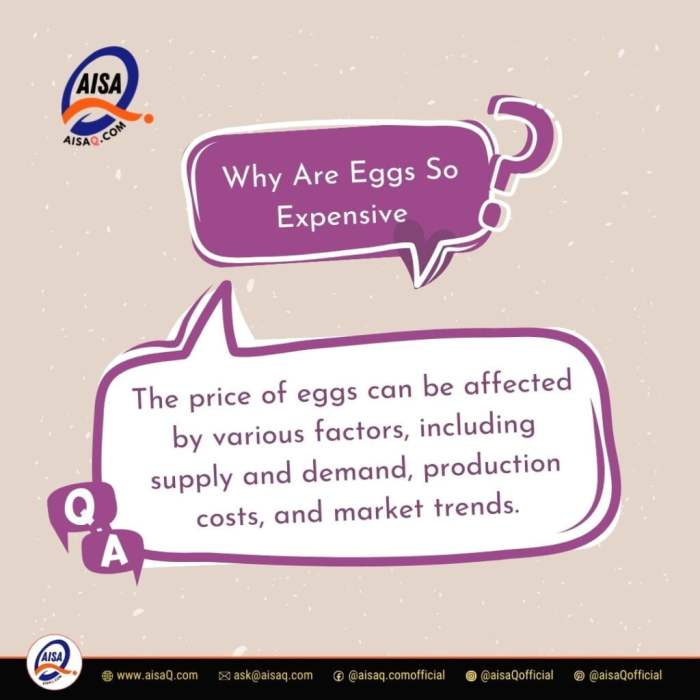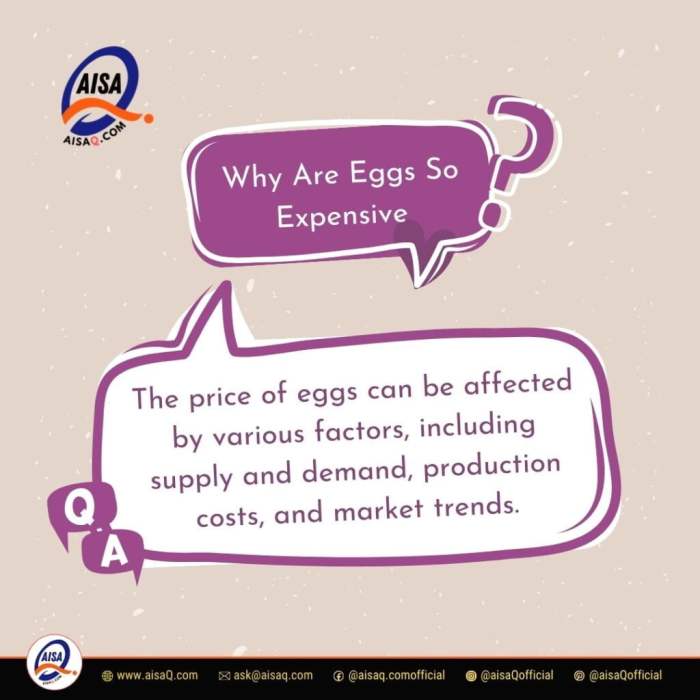
Why eggs are so expensive right now? The soaring cost of a simple breakfast staple has got everyone scratching their heads. From disrupted supply chains to rising production costs, a complex web of factors is driving up the price of eggs. This post dives deep into the multifaceted reasons behind this egg-centric economic conundrum, examining everything from the impact of global events to consumer demand and even the role of alternative protein sources.
The current state of the global egg supply chain is significantly impacted by a multitude of interconnected factors. Transportation challenges, labor shortages, and fluctuating raw material costs all contribute to increased production expenses. Comparing these current disruptions with past events like pandemics and extreme weather reveals a recurring theme of instability in the egg market. The rising costs of feed for chickens, influenced by inflation and energy prices, further exacerbate the situation.
Farmers are adapting to these challenges in various ways, but the overall effect on the cost of a single egg is substantial.
Supply Chain Disruptions

The global egg market, like many other industries, is facing significant disruptions. These disruptions are not new, but the compounding effect of various factors is pushing egg prices higher. Understanding the intricate web of the egg supply chain and the factors affecting it is crucial to comprehending the current price volatility.
Current State of the Global Egg Supply Chain
The global egg supply chain is complex, involving farmers, processors, distributors, and retailers. Disruptions at any point along this chain can ripple through the entire system, impacting availability and prices. Currently, multiple factors are simultaneously affecting egg production, creating a perfect storm that is driving up costs.
Key Factors Impacting Egg Production
Several key factors are impacting egg production, including transportation, labor, and raw material costs. These factors often interact, exacerbating the impact on egg prices.
- Transportation Costs: Rising fuel costs are directly impacting transportation expenses for transporting eggs from farms to processing plants and then to retail outlets. This increase in transportation costs is a major contributor to the higher prices consumers are seeing at the supermarket.
- Labor Shortages: The labor market, particularly in rural areas where many egg farms are located, is experiencing shortages of workers. This shortage is impacting egg production by limiting the number of eggs that can be collected, processed, and delivered to market.
- Raw Material Costs: Feed costs for chickens, including grains like corn and soy, have risen due to global market conditions, impacting the overall cost of producing eggs. The price of feed is directly correlated with the cost of eggs, and increases are a major contributing factor.
Comparison with Previous Disruptions
Supply chain disruptions are not unique to the current economic climate. Past disruptions, such as pandemics and extreme weather events, have also significantly impacted the egg supply chain. However, the current confluence of factors is making the situation more complex and challenging to recover from.
| Disruption Type | Location | Impact on Production | Recovery Timeline |
|---|---|---|---|
| 2022 Avian Influenza Outbreak | North America, Europe | Significant reduction in egg supply, leading to substantial price increases. | Varied, depending on the severity of the outbreak in each region. Some areas took several months to recover. |
| 2020 COVID-19 Pandemic | Globally | Labor shortages and disruptions in transportation and supply chains, affecting egg production. | Several months, with some ongoing impacts. |
| 2023 Extreme Weather Events (Droughts, Floods) | Various regions globally | Reduced feed availability, impacting feed costs and ultimately impacting egg production | Recovery time depends on the intensity and duration of weather events. Some areas are still recovering from previous events. |
Examples of Current Disruptions
The recent avian flu outbreaks have significantly impacted egg production in several countries. This has led to reduced egg availability and a surge in prices. These types of disruptions highlight the vulnerability of the global egg supply chain to unexpected events.
Increased Production Costs
The rising cost of eggs isn’t just about disruptions in the supply chain; it’s also a reflection of escalating production expenses for farmers. Feed costs, energy prices, and general inflation are all contributing factors, making it harder for egg producers to maintain profitability and keep prices stable. This deeper dive explores the intricacies of these rising costs and the adaptations farmers are making to navigate this challenging economic landscape.The cost of producing a single egg is influenced by a complex interplay of factors.
These factors, including feed, labor, energy, and other inputs, all experience fluctuations, which directly impact the final price consumers pay. Understanding these elements is crucial to grasping the multifaceted nature of the current egg market.
Rising Feed Costs for Chickens
The price of feed, the cornerstone of poultry farming, has seen significant increases. Corn and soybean meal, the primary ingredients in poultry feed, are influenced by global market forces and domestic weather patterns. Droughts, floods, and other unpredictable weather events can impact crop yields, leading to price hikes. Simultaneously, increased demand from other industries, like biofuel production, also contributes to higher feed costs.
Eggs are sky-high right now, aren’t they? It’s a frustrating price hike, and while there are various contributing factors, a lot of recent agricultural challenges are at play. Interestingly, the history efforts to end the Department of Education, like history efforts end department of education , might seem unrelated, but the ripple effect of such policy changes can indirectly impact food production and distribution, further pushing up the price of everyday staples like eggs.
So, while the reasons are complex, the end result is still those expensive eggs.
Farmers are forced to absorb these increases or pass them on to consumers, often resulting in higher egg prices.
Impact of Inflation on Farming Expenses
Inflation is not just affecting everyday consumer goods; it’s also impacting the agricultural sector. Fuel costs, fertilizer prices, and labor wages all rise with inflation, increasing operational expenses for farms. Farmers often have limited ability to adjust their pricing strategies immediately to counter rising expenses. Consequently, these increased costs are often passed on to consumers, adding to the overall price of eggs.
The Role of Energy Costs in Egg Production
Energy, particularly electricity and natural gas, is essential for powering farm equipment, maintaining proper temperature and ventilation in poultry houses, and running processing facilities. Fluctuations in energy prices directly impact the cost of egg production. Increased energy costs increase the operational expenses of egg farms, impacting the bottom line and often leading to price adjustments. Farmers face a challenge balancing energy efficiency with maintaining optimal conditions for their birds.
Examples of Farmer Adaptations to Rising Costs
Farmers are proactively implementing strategies to mitigate the impact of rising production costs. These strategies can range from improving feed efficiency to adopting more energy-efficient technologies. Some examples include using feed additives to improve feed conversion, implementing solar panels to reduce reliance on grid electricity, and exploring alternative feed ingredients. These adjustments, while not always fully effective, represent the proactive measures farmers are taking to adapt.
Eggs are sky-high right now, aren’t they? It’s all about supply and demand, of course, but maybe there’s a hidden cost involved. Did you know about the recent incident with Macron’s wife, Brigitte, on a plane? macron wife brigitte plane shove While that’s certainly newsworthy, it doesn’t explain the egg shortage. Still, it does make you wonder about the ripple effects of global events and how they can impact even something as seemingly simple as the price of a dozen eggs.
Breakdown of Increased Costs for a Single Egg
| Cost Category | Estimated Increase (USD) |
|---|---|
| Feed | 0.15 |
| Labor | 0.05 |
| Energy | 0.08 |
| Other Inputs (e.g., veterinary care, supplies) | 0.02 |
| Total Estimated Increase Per Egg | 0.30 |
Note: This table represents an estimated breakdown and can vary depending on the specific farm and market conditions.
Demand and Consumption Patterns
Egg prices have skyrocketed in recent months, and while supply chain disruptions and increased production costs certainly play a role, consumer demand and its fluctuations are equally important factors to consider. Understanding how egg consumption patterns have changed and are currently trending is key to understanding the full picture of this market. Examining past data and current consumption trends can help explain the current price volatility.Understanding the interplay between consumer demand and market supply is critical to predicting future price movements.
Changes in consumer preferences, health concerns, and overall economic conditions can significantly impact the demand for eggs, leading to price fluctuations. Historical trends and current consumption patterns offer insights into the dynamics of this market.
Current Egg Consumption Trends
Egg consumption is a staple in many diets worldwide. Trends in egg consumption can be influenced by a variety of factors, including dietary shifts, health concerns, and economic conditions. Changes in consumption patterns are important for understanding the current market conditions and forecasting future price movements.
Factors Influencing Consumer Demand
Dietary shifts are among the most significant factors influencing consumer demand for eggs. The rise of vegetarianism and veganism has impacted egg consumption in some regions, but eggs remain a popular protein source for many. Health concerns also play a role, as the perceived health benefits of eggs have fluctuated over time. This has influenced consumer preferences and the demand for different types of eggs, including organic or cage-free options.
Comparison to Historical Data
Analyzing historical data on egg consumption can provide a valuable context for understanding the current market. For example, the availability of cheaper substitutes, the popularity of certain dietary trends, and changes in consumer perceptions of eggs all influence the quantity demanded. This historical data can be compared to the current market trends to gain a clearer picture of the current situation.
Growth or Decline in Egg Consumption
Data on egg consumption trends over time shows a mixed picture. In some regions, consumption has remained relatively stable, while in others, it has increased or decreased. Changes in per capita consumption often correlate with economic factors, health concerns, and changing dietary preferences. These factors need to be considered when assessing the impact on the current market.
Table of Egg Consumption Trends
| Time Period | Consumption per Capita (estimated) | Reasons for Change |
|---|---|---|
| 2010-2015 | 200 eggs | Steady consumption, moderate dietary shifts, no major health concerns |
| 2016-2020 | 215 eggs | Continued consumption, moderate growth in health-conscious consumerism, introduction of new egg products |
| 2021-2023 | 205 eggs | Slight decrease due to inflation, rising prices of other protein sources, and potential concerns regarding egg production methods. |
Weather Events and Natural Disasters
The egg industry, like many agricultural sectors, is vulnerable to the unpredictable forces of nature. Extreme weather events, ranging from scorching heatwaves to devastating floods, can disrupt the entire production chain, impacting everything from feed availability to the health and productivity of laying hens. These disruptions can have a cascading effect, contributing to the rising cost of eggs we’re seeing across the market.
Impact of Extreme Temperatures
Extreme temperatures, whether scorching heat or frigid cold, directly affect the health and productivity of laying hens. High temperatures can lead to dehydration and heat stress, reducing egg production and quality. Conversely, freezing temperatures can negatively impact feed intake and overall well-being. These conditions also affect the quality of the feed itself, potentially reducing nutritional value and impacting the hens’ ability to lay eggs.
For example, a prolonged heatwave can decrease the feed conversion ratio for hens, meaning more feed is needed to produce the same amount of eggs. This directly translates to higher production costs.
Effects of Floods and Droughts
Floods and droughts pose significant challenges to egg production. Floods can damage or destroy farms, including hen houses, feed storage facilities, and transportation infrastructure. This can lead to a complete or partial shutdown of operations for an extended period, significantly reducing egg availability. Droughts, conversely, can result in shortages of feed crops like corn and soybeans, the primary ingredients in chicken feed.
This scarcity drives up feed costs and directly affects egg prices. The disruption of water supplies for irrigation and drinking also affects both hens and farm workers. In regions heavily reliant on rainfall for agriculture, drought conditions can lead to a severe decline in egg production.
Regional Impacts and Recovery Times
The effects of weather events vary significantly across different regions. The impact depends on the severity and duration of the event, the region’s preparedness, and the resilience of the local farming practices.
| Region | Weather Event | Impact on Production | Recovery Time |
|---|---|---|---|
| California, USA | Prolonged Drought (2022-2023) | Significant decrease in feed availability, increased feed costs, and reduced egg production across the state. | Varied, depending on the severity of the drought and the availability of water resources for irrigation. Some farms might not recover fully within a year. |
| Southeast Asia | Heavy Rainfall and Flooding (2023) | Damage to farms, disruption of supply chains, and temporary shutdown of egg production in several regions. | Varied, depending on the extent of the damage and the time taken to rebuild infrastructure and restore operations. |
| Central Europe | Extreme Heatwave (2022) | Heat stress for laying hens, reduced egg production, and higher mortality rates in some regions. | Usually, the impact is temporary, and production returns to normal once the weather cools down. |
Government Policies and Regulations
Government policies play a significant role in shaping the egg market. These policies, whether supporting or hindering production, can directly influence the cost of eggs for consumers. Regulations regarding farm practices, environmental standards, and food safety can all affect egg prices. Furthermore, subsidies and support programs for egg producers can either lower production costs or increase the availability of eggs, thereby impacting consumer prices.
Understanding these policies is crucial to comprehending the complexities of egg price fluctuations.Government interventions, including regulations and subsidies, can significantly impact the cost of eggs. Policies on animal welfare, environmental protection, and food safety standards can increase production costs, thus potentially raising egg prices. Conversely, subsidies designed to encourage production or lower production costs could lead to lower egg prices.
Comparing policies across different countries provides valuable insights into how diverse approaches affect egg prices and market dynamics.
Government Subsidies and Support Programs
Government subsidies for egg producers often focus on research and development, improved farm infrastructure, and the adoption of sustainable farming practices. These programs aim to boost productivity and efficiency, which in turn could lead to lower production costs and potentially lower prices for consumers. However, the effectiveness of these programs in lowering egg prices can vary significantly based on the specific policy design, the financial resources allocated, and the overall economic context.
Government Policies Affecting Egg Prices by Country
A comparative analysis of policies across different countries reveals a wide range of approaches. Some countries may have more stringent regulations concerning animal welfare and environmental protection, which could lead to higher production costs and potentially higher egg prices. Other countries might provide substantial subsidies to egg producers, aiming to increase domestic egg production and potentially lower consumer prices.
| Country | Policy Details | Impact on Egg Prices |
|---|---|---|
| United States | Various state and federal regulations concerning farm practices, animal welfare, and food safety standards. Limited direct subsidies for egg producers compared to some other countries. | Regulations can increase production costs, potentially leading to slightly higher egg prices. Limited direct support might not significantly affect prices. |
| Netherlands | Strong emphasis on sustainable farming practices, including environmental regulations. Government support for research and development in poultry farming. | Stringent regulations might increase production costs, but investments in research and development could potentially lead to efficiencies and lower costs in the long term. |
| France | Government subsidies and support programs for egg producers, potentially aimed at encouraging domestic production. Strict regulations on animal welfare and environmental protection. | Subsidies could lower egg prices, but strict regulations may increase production costs, resulting in a complex impact on prices. |
Comparative Analysis of Policies
Different countries adopt diverse policies based on their unique economic situations, cultural values, and environmental priorities. A comparative analysis helps highlight the potential impacts of these variations on egg prices and market dynamics. For instance, countries with stringent animal welfare regulations might see higher egg prices due to increased production costs, while countries offering subsidies for egg production could potentially see lower prices.
Alternative Protein Sources
The rising popularity of plant-based proteins, coupled with concerns about sustainability and health, presents a significant shift in consumer preferences. This shift is impacting not just the food industry, but also the agricultural sector, as consumers seek diverse protein options beyond traditional animal products. This burgeoning interest in alternative proteins has created a competitive landscape, prompting innovation and driving demand for various plant-based alternatives.
Eggs are sky-high right now, aren’t they? It’s a tricky situation, with everything from avian flu to the crazy weather impacting supply chains. Plus, there’s a whole lot of discussion around the topic of “Philip Cooper Operation Gateway Inreach,” which, I admit, I’m still trying to get my head around. Philip Cooper Operation Gateway Inreach seems to have a lot of potential implications for various industries, but its direct impact on egg prices is still a bit of a mystery to me.
Ultimately, it’s all part of the bigger picture of why we’re seeing such inflated prices at the grocery store.
Growing Popularity of Plant-Based Proteins
Consumers are increasingly seeking protein sources that align with their values and dietary needs. This includes ethical concerns, environmental consciousness, and health motivations. Plant-based protein sources, such as soy, pea, and lentil protein, offer an attractive alternative to animal-based proteins, appealing to both health-conscious individuals and environmentally aware consumers. Companies are capitalizing on this trend by developing innovative products like plant-based burgers, meat substitutes, and protein powders, further driving the market growth.
Influence on Egg Demand
The rise of plant-based protein options is likely to influence egg demand, albeit in a nuanced way. While some consumers may continue to favor eggs for their unique nutritional profile, others might choose plant-based alternatives for various reasons. The accessibility and affordability of plant-based proteins could potentially reduce the demand for eggs in certain segments of the market.
Nutritional Comparison
Comparing the nutritional value of eggs to alternative protein options reveals a complex picture. Eggs are a complete protein, containing all essential amino acids. Plant-based proteins, while often lower in some essential amino acids, can be part of a balanced diet when combined with other sources.
Long-Term Implications for the Egg Industry
The long-term implications for the egg industry are multifaceted. The industry will need to adapt to changing consumer preferences and potentially explore innovative strategies to remain competitive. This might include developing more sustainable farming practices and highlighting the unique nutritional benefits of eggs in comparison to plant-based alternatives. The ongoing innovation in the alternative protein sector will likely continue to drive the demand for plant-based products.
Nutritional Content Comparison Table
| Nutrient | Egg (Large, whole) | Soy Protein | Pea Protein | Lentil Protein |
|---|---|---|---|---|
| Protein (g) | 6.3 | 20-25 (per serving) | 10-15 (per serving) | 8-12 (per serving) |
| Fat (g) | 5 | 0.5-1.0 (per serving) | 0.5-1.0 (per serving) | 0.5-1.0 (per serving) |
| Cholesterol (mg) | 185 | 0 | 0 | 0 |
| Vitamin B12 (mcg) | 0.5 | 0 | 0 | 0 |
| Iron (mg) | 0.6 | 0.5-1.0 (per serving) | 0.5-1.0 (per serving) | 1.0-2.0 (per serving) |
Note: Nutritional content can vary based on specific product and preparation methods. Serving sizes for plant-based protein sources are approximate.
Farm Practices and Efficiency: Why Eggs Are So Expensive Right Now
Modern egg production relies heavily on optimized farming practices to ensure efficiency and profitability. These practices, while often successful in maximizing output, sometimes come with trade-offs in terms of animal welfare and environmental impact. Understanding these practices is crucial to comprehending the complexities of the current egg market.
Modern Farming Practices
Modern egg farming often involves large-scale operations, carefully designed to maximize productivity. These operations utilize specialized housing systems, meticulously controlled environments, and precisely calibrated feeding regimens. The goal is to optimize egg production per hen while minimizing operational costs. This often involves close monitoring of hen health, disease prevention, and efficient egg collection.
Increasing Production Efficiency
Several strategies can boost egg production efficiency. Improved breeding programs, aimed at higher egg-laying rates and disease resistance, are a key element. Advanced feeding techniques, using optimized nutrition plans, can also contribute significantly to higher output. Furthermore, optimizing housing layouts and incorporating automation in egg collection can significantly increase efficiency and reduce labor costs.
Technology’s Role in Modern Egg Farming
Technology plays an increasingly important role in modern egg farming. Automation, including automated feeding systems and egg collection robots, is rapidly becoming more commonplace, streamlining processes and reducing labor needs. Precision livestock farming (PLF) techniques are employed to track individual hen performance, enabling data-driven adjustments to feeding and management strategies. Sensors and data analytics provide valuable insights into hen health and behavior, facilitating proactive interventions and disease prevention.
Innovative Technologies
Several innovative technologies are impacting egg production. For example, advanced lighting systems mimic natural daylight cycles, optimizing hen activity and egg production. Furthermore, the use of automated ventilation systems helps to regulate temperature and humidity, improving hen comfort and reducing environmental stress. These technologies contribute to increased efficiency and sustainability in egg production.
Benefits and Drawbacks of Different Farming Practices, Why eggs are so expensive right now
“Intensive farming practices, often focused on maximizing output, can lead to high efficiency and profitability but may raise concerns about animal welfare and environmental sustainability. Conversely, more sustainable practices, while potentially reducing output, often prioritize animal well-being and environmental protection.”
- Cage-free systems prioritize animal welfare, allowing for more natural movement and behavior. However, these systems can be more challenging to manage in terms of space requirements and potential disease outbreaks.
- Cage systems offer economies of scale and easier management, but often face criticism for their potential impact on bird welfare due to confined spaces.
- Free-range systems offer more space and opportunities for natural behaviors. But, they can be challenging to manage in terms of egg collection, and can be more vulnerable to predators.
Conclusion

In conclusion, the high cost of eggs today isn’t a simple story. It’s a confluence of global events, economic pressures, and shifting consumer preferences. From supply chain disruptions to the increasing popularity of alternative proteins, the egg industry faces a complex web of challenges. While farmers strive to adapt and improve efficiency, the ultimate impact on consumer wallets remains a significant concern.
Ultimately, the future of egg prices hinges on how these interconnected factors evolve and how quickly the industry can adjust.







